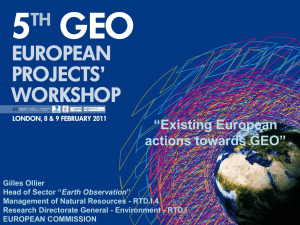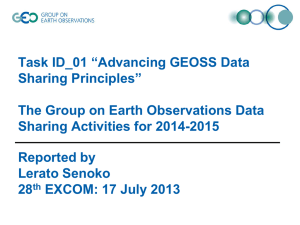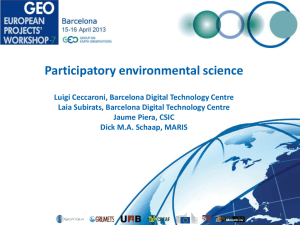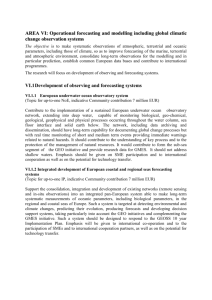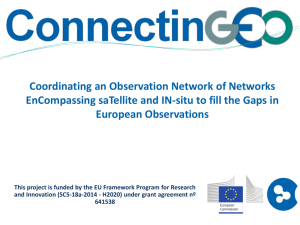European Earth Observation Priorities and Challenges in the GEOSS Era –... Project EUGENE
advertisement
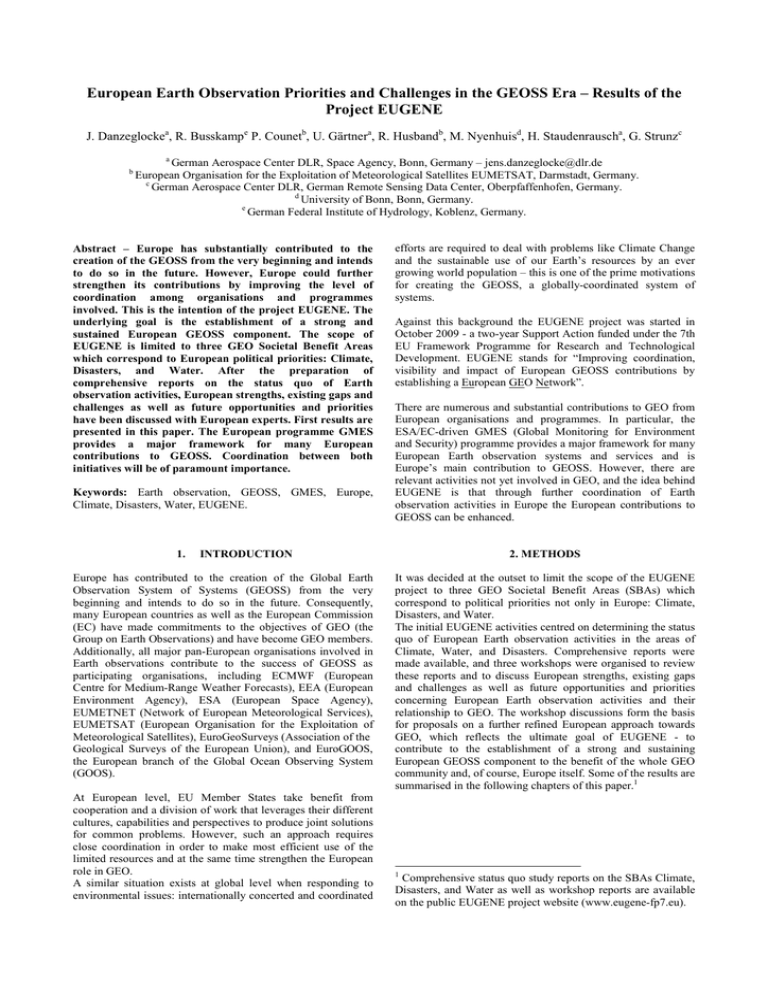
European Earth Observation Priorities and Challenges in the GEOSS Era – Results of the Project EUGENE J. Danzeglockea, R. Busskampe P. Counetb, U. Gärtnera, R. Husbandb, M. Nyenhuisd, H. Staudenrauscha, G. Strunzc b a German Aerospace Center DLR, Space Agency, Bonn, Germany – jens.danzeglocke@dlr.de European Organisation for the Exploitation of Meteorological Satellites EUMETSAT, Darmstadt, Germany. c German Aerospace Center DLR, German Remote Sensing Data Center, Oberpfaffenhofen, Germany. d University of Bonn, Bonn, Germany. e German Federal Institute of Hydrology, Koblenz, Germany. Abstract – Europe has substantially contributed to the creation of the GEOSS from the very beginning and intends to do so in the future. However, Europe could further strengthen its contributions by improving the level of coordination among organisations and programmes involved. This is the intention of the project EUGENE. The underlying goal is the establishment of a strong and sustained European GEOSS component. The scope of EUGENE is limited to three GEO Societal Benefit Areas which correspond to European political priorities: Climate, Disasters, and Water. After the preparation of comprehensive reports on the status quo of Earth observation activities, European strengths, existing gaps and challenges as well as future opportunities and priorities have been discussed with European experts. First results are presented in this paper. The European programme GMES provides a major framework for many European contributions to GEOSS. Coordination between both initiatives will be of paramount importance. Keywords: Earth observation, GEOSS, GMES, Europe, Climate, Disasters, Water, EUGENE. 1. efforts are required to deal with problems like Climate Change and the sustainable use of our Earth’s resources by an ever growing world population – this is one of the prime motivations for creating the GEOSS, a globally-coordinated system of systems. Against this background the EUGENE project was started in October 2009 - a two-year Support Action funded under the 7th EU Framework Programme for Research and Technological Development. EUGENE stands for “Improving coordination, visibility and impact of European GEOSS contributions by establishing a European GEO Network”. There are numerous and substantial contributions to GEO from European organisations and programmes. In particular, the ESA/EC-driven GMES (Global Monitoring for Environment and Security) programme provides a major framework for many European Earth observation systems and services and is Europe’s main contribution to GEOSS. However, there are relevant activities not yet involved in GEO, and the idea behind EUGENE is that through further coordination of Earth observation activities in Europe the European contributions to GEOSS can be enhanced. INTRODUCTION Europe has contributed to the creation of the Global Earth Observation System of Systems (GEOSS) from the very beginning and intends to do so in the future. Consequently, many European countries as well as the European Commission (EC) have made commitments to the objectives of GEO (the Group on Earth Observations) and have become GEO members. Additionally, all major pan-European organisations involved in Earth observations contribute to the success of GEOSS as participating organisations, including ECMWF (European Centre for Medium-Range Weather Forecasts), EEA (European Environment Agency), ESA (European Space Agency), EUMETNET (Network of European Meteorological Services), EUMETSAT (European Organisation for the Exploitation of Meteorological Satellites), EuroGeoSurveys (Association of the Geological Surveys of the European Union), and EuroGOOS, the European branch of the Global Ocean Observing System (GOOS). At European level, EU Member States take benefit from cooperation and a division of work that leverages their different cultures, capabilities and perspectives to produce joint solutions for common problems. However, such an approach requires close coordination in order to make most efficient use of the limited resources and at the same time strengthen the European role in GEO. A similar situation exists at global level when responding to environmental issues: internationally concerted and coordinated 2. METHODS It was decided at the outset to limit the scope of the EUGENE project to three GEO Societal Benefit Areas (SBAs) which correspond to political priorities not only in Europe: Climate, Disasters, and Water. The initial EUGENE activities centred on determining the status quo of European Earth observation activities in the areas of Climate, Water, and Disasters. Comprehensive reports were made available, and three workshops were organised to review these reports and to discuss European strengths, existing gaps and challenges as well as future opportunities and priorities concerning European Earth observation activities and their relationship to GEO. The workshop discussions form the basis for proposals on a further refined European approach towards GEO, which reflects the ultimate goal of EUGENE - to contribute to the establishment of a strong and sustaining European GEOSS component to the benefit of the whole GEO community and, of course, Europe itself. Some of the results are summarised in the following chapters of this paper.1 1 Comprehensive status quo study reports on the SBAs Climate, Disasters, and Water as well as workshop reports are available on the public EUGENE project website (www.eugene-fp7.eu). 3. CLIMATE 3.1 The Challenge and the GEOSS Strategic Target Average global temperatures are on the increase, ice and snow cover is disappearing fast, and sea levels are rising. In addition, the impact of severe weather situations is becoming more extreme. There is clear evidence that the Earth’s atmosphere and oceans are warming. Climate change is a reality and it is probably one of the biggest challenges in the history of humankind. The evolution of the Earth’s climate is characterised by a complex global interplay of influences, including the sun, atmosphere, land, surface, snow and ice, oceans, seas, biosystems, and of course the human race. To better understand the global climate system, and especially to be able to anticipate its future evolution, not only do we need global data sets, but we must also coordinate climate analysis, modelling, and predictions in order to accurately establish the current state of the climate and to create powerful tools for climate prediction. Thus, the following GEOSS Climate Target was adopted in 2009 (GEO, 2009): “Before 2015, GEO aims to achieve effective and sustained operation of the global climate observing system and reliable delivery of climate information of a quality needed for predicting, mitigating and adapting to climate variability and change, including for better understanding of the global carbon cycle.” 3.2 European Capabilities, Priorities, and Challenges Europe is very well positioned to respond to the challenges of Climate (change) observation with world-class capabilities and systems, e.g.: • systematic meteorological observation networks (both in-situ and space-based) together with the associated long-term archives, with in-situ record lengths of over one hundred years in some cases and satellite record lengths spanning over 30 years; • long-term, operational programmes designed to ensure continuity of meteorological satellite observations; • extensive modelling capabilities addressing Earth system processes, Reanalysis and Climate Prediction and Projections; • the long-term commitments of operational agencies to generate and maintain Climate Data Records; • the research and development investment in observing systems (which in some cases are the precursors of operational systems); • the commitment of the EC to address climate issues through the use of Research Funding. This extensive range of capabilities and systems is underpinned by Europe's strong political will to address climate issues. Consequently, Europe is very well integrated within the key international frameworks ranging from overarching frameworks such as the UNFCCC, IPCC, and GCOS, through to key implementation frameworks which are, in turn, closely connected to the implementation of the relevant GEO climate tasks and targets. This participation by European organisations, such as ESA, EUMETSAT, ECMWF, and EUMETNET, in international frameworks is augmented by strong individual contributions from European Countries. A large number of national institutions are engaged in international cooperation (e.g. meteorological services, oceanographic services, modelling centres and in-situ data centres). The role of national institutions is particularly significant in the provision of in-situ data, due to the strong dependence on national infrastructures for in-situ data collection, and a significant number of the international in-situ data centres are hosted by national institutions within Europe. While Europe’s Climate observation systems are already at a high level, the following areas were identified as candidates for targeted actions to further strengthen Europe's contribution to the fulfilment of the GEOSS Climate Target: • Maintenance and extension of terrestrial and oceanic in-situ networks, filling remaining regional gaps, and strengthening of access to in-situ data; • creation of long time-series Climate Data Records along with measures for data rescue and homogenisation; • construction of long time-series of Essential Climate Variables based on satellite data, where possible; • implementation of standards for metadata documentation; • realisation of regular Reanalysis cycles. Some of the above-mentioned areas are clearly linked to the need for long-term funding and the conversion of current research activities into operational programmes. The forthcoming GMES Core Climate Service is a potential vehicle for establishment of these sustained Climate observation activities in Europe. European climate activities are already well-coordinated at an international level (e.g. through GCOS and the future Global Framework for Climate Services). Therefore, GEO may not be regarded as the prime international coordination framework for Climate in general. However, GEO plays a useful role in filling gaps, such as facilitating an international framework for a carbon monitoring system, and in providing bridges to political systems. 4. DISASTERS 4.1 The Challenge and the GEOSS Strategic Target Disaster risk and vulnerability are increasing in many regions of the world. Natural hazards are a major cause of loss of life and property, and affect key natural resources. Disaster-induced losses can be reduced through the timely, accurate and reliable provision of Earth observation data. To support disaster management it is essential to provide information through coordinated systems in order to contribute to monitoring, prediction, risk assessment, early warning, mitigation, and response measures. This requires extensive integration of diverse data streams, improved information extraction methods and modelling capabilities, and the generation and dissemination of the information needed by decision makers and the public. The GEO Strategic Target for the Disasters SBA (GEO, 2009) emphasises the issue of global coordination of disaster-related systems: “Before 2015, GEO aims to enable the global coordination of observing and information systems to support all phases of the risk management cycle associated with hazards (mitigation and preparedness, early warning, response, and recovery).” 4.2 European Capabilities, Priorities, and Challenges Substantial European developments and contributions to GEO are provided in the framework of GMES. The GMES Emergency Response Services are being developed in several European research projects. Important contributions are currently being made by the GMES SAFER project (Services and Applications for Emergency Response). It provides emergency mapping services for situation analysis and damage assessment as well as reference mapping services to support preparedness and risk assessment. High priority is given to quality assurance and validation of the services. Moreover, a couple of European Services are provided on an operational basis, e.g. by the EC Joint Research Centre, such as the European Flood Alert System (EFAS), the European Forest Fire Information System (EFFIS), or the Global Disaster Alert and Coordination System (GDACS). The Global Fire Monitoring Center (GFMC) provides a global portal for wildland fire monitoring, which is based on a worldwide network of cooperating institutions. Furthermore, ESA and some national European Space Agencies substantially contribute to the GEO Supersites Initiative which provides access to spaceborne and in-situ geophysical data of selected sites prone to hazards, such as earthquakes or volcanic eruptions. Based on discussions with key European stakeholders, a couple of gaps and potential opportunities to strengthen Europe’s contributions to the achievement of the GEO strategic target have been identified, such as: • The coordination of services which use Earth observation data to provide information for disaster management should be improved at global level. The activities of the European GMES Emergency Response Service and international activities like the International Charter on Space and Major Disasters, UN Space Aid, Sentinel Asia, and SERVIR should be harmonised to optimise the benefit from all these activities for the users. European institutions should support this coordination within the framework of GEO. • The access to in-situ data and data integration into the Emergency Response Services should be facilitated. The combination of satellite based crisis information with in-situ data is a key issue. • The interaction and link between forecast services and emergency response services should be improved. For instance, for hydro-meteorological hazards a number of operational forecast and early warning systems exist in Europe and worldwide. In order to improve the reaction time emergency response mapping services should establish closer links to these forecast services. • The transfer of research and development results into operational services should be fostered, especially in the framework of GMES. Within the GMES framework, the emergency response activity, which has been established with the help of ESA and EC research funding, is already in the transitional phase of becoming an operational service. Clearly, it can be identified as a priority area within European Earth observation activities. The GMES emergency response service will not only address European requirements but also make available operational capacities and resources in an international context. It will provide the means that will allow Europe to contribute even more than today to the whole field of international disaster response within the framework of GEOSS and the International Charter on Space and Major Disasters. 5. WATER 5.1 The Challenge and the GEOSS Strategic Target Reliable supplies of freshwater are essential for human health, well-being, and prosperity. Likewise, ecosystem functioning depends to a large degree on the availability of clean water. Due to global environmental change and human activities, there is an increasing pressure on water resources in many regions of the world. To achieve sustainable management of the world’s water resources an improved knowledge of the hydrological cycle is required. Sustained observation systems that acquire water cycle data and make this data accessible to the wider community are essential to achieve this important goal. Thus, the GEO Strategic Target for the Water SBA reads (GEO, 2009): “Before 2015, GEO aims to produce comprehensive sets of data and information products to support decision-making for efficient management of the world's water resources, based on coordinated, sustained observations of the water cycle on multiple scales.” 5.2 European Capabilities, Priorities, and Challenges Europe is well positioned to contribute to the achievement of the GEO target for the Water SBA due to its Earth observation capabilities and expertise in the water sector, e.g.: • Operational hydrological networks, established and maintained by European National Hydrological Services (NHS); • several pan-European Earth observation data archives that contain information on water quality and water quantity for European freshwaters, e.g. the Water Information System for Europe (WISE), or the European Water Archive (EWA); • the European Water Framework Directive (WFD) as a legal basis for integrated water resources management, international cooperation and data exchange, especially for transboundary river basins; • Remote sensing technologies that deliver relevant hydrological parameters, e.g. ESA’s SMOS (Soil Moisture and Ocean Salinity) and the future GMES Sentinel satellite missions. Several European programmatic frameworks contribute to the goals of GEO in the water sector, e.g.: • The GMES programme, which encompasses water resource and food security services and products in Europe, but also at global level, and with a special focus on Africa; • engagement in capacity building for Earth observations through dedicated programmes such as PUMA, EUMETCast, TIGER and AMESD and various national European projects. The GMES Africa Action Plan as a joint effort of the African Union (AU) and the EU under the auspices of the EU-Africa partnership on Science, Information Society and Space, will aim at jointly developing a strategy to provide sustainable, reliable and timely Earth observation information services and products related to environmental and security issues in Africa. Europe has developed extensive capabilities in Earth observation that are contributing to the implementation of key international frameworks such as GCOS/GTOS, the UNESCO International Hydrological Programme (IHP) and the Hydrology and Water Resources Programme (HWRP). European countries support these international cooperation efforts, e.g. by hosting international data centres such as the Global Runoff Data Centre (GRDC), the Global Precipitation Climatology Centre (GPCC) and the International Groundwater Resources Assessment Centre (IGRAC) and by providing scientific expertise. It is Europe’s intention to identify opportunities to strengthen its contribution to the achievement of the GEO target for the Water SBA. Important developments in the framework of GMES are currently ongoing, such as the “GMES and Africa” process and the coordination of the GMES in-situ component under the auspices of the European Environment Agency (EEA). Based on discussions with key European stakeholders in the water sector, the following gaps and potential opportunities, among others, have been identified for Europe to start targeted actions: • Strengthen the role of water quality and groundwater observations; • strengthen the coordination of in-situ observations of water cycle components; • promote full and open access to hydrological data, since restrictive and complex data policies pose a major obstacle so far; • Capacity Building in Water-related Earth observations, especially through GMES Africa. Europe is implementing the Infrastructure for Spatial Information in Europe (INSPIRE) programme to build up standards and rules for a consistent and interoperable geo-data infrastructure. INSPIRE sets a legal framework as well as technical implementation rules for Europe and also provides a substantial European input for the implementation of the GEOSS Common Infrastructure (GCI). 6. CROSS-CUTTING ASPECTS Within Europe, national and pan-European responses to the process of establishing the GEOSS have already been initiated. The transfer of GMES into the initial operations phase (20112013) is an important milestone to establish a sustainable and long-term Earth observation programme in Europe. Such a programme will provide key European activities with secure long-term (as opposed to research-oriented) funding. Full and open availability of the data produced (for local, regional, national and international users) is a key element of the GMES programme. For example the future Sentinel Missions will not only provide sustainable satellite resources for the GMES services; the data policy for Sentinel satellite data will generally allow free access to the data, which is in compliance with the GEO Data Sharing Principles. Thus, the opportunity arises to further dovetail GMES developments with GEO in order to assure that Europe effectively contributes to GEOSS and benefits as much as possible from GEOSS. As GMES intends to be a Europeanbased “Global Monitoring” programme for environmental and security purposes, to some extent GEOSS can facilitate the global perspective of GMES. However, whereas the current focus of GEOSS is on the acquisition and broad availability of datasets, GMES is developing and establishing operational Earth observation “services”. There are indications that under the framework of GEO after the ongoing 2005 to 2015 GEOSS implementation phase a similar global development might be agreed upon. Synergies between GMES and GEOSS could also be generated in the area of user engagement. Whereas GMES services are targeting defined end users, the GEO User Interface with its Communities of Practice represents a different kind of user community, consisting of rather intermediate, scientific users and value-adders instead of end users. Undoubtedly, GMES and GEOSS could learn from each other in the field of user engagement. Representatives of GMES should therefore intensify their engagement in GEO committees, task teams, and Communities of Practice. Additionally, whilst the EC is continually funding GEOSSrelated research, an increased involvement of European research communities within both GMES and GEO should be encouraged, and the transfer of research and development results into operational systems should be further fostered. Since the GMES in-situ component will to a great extent be based on European infrastructures operated by national entities, the establishment of this component may in particular benefit from GEO’s political momentum and, in turn, strengthen the European capability to substantially contribute to GEOSS. Again, there is an evident opportunity to generate synergies, since globally homogeneous data is needed to respond to global environmental issues in Europe and elsewhere. Similarly, actions should be coordinated in the field of capacity building in order to avoid double work and effectively enable the developing world to better utilise Earth observations. Finally, Europe values the important role of GEO not only with respect to the provision of bridges to political systems but also regarding global observational gaps and the establishment of required global frameworks and standards, such as the global carbon monitoring system and the biodiversity observation network. 7. CONCLUSIONS Europe will continue to contribute to GEO in providing a strong and sustained component to the GEOSS. Besides numerous and substantial contributions from other European organisations and national programmes, the European GMES programme will form the major framework for European contributions to GEOSS. As presented in this paper, coordination between GMES and GEOSS and generation of synergies in their further development will be of paramount importance. Coordinated actions in areas such as data sharing and data standards, capacity building, user engagement, exchange and linkages between science and operational systems, and the filling of global observational gaps are indispensable in the light of today’s global environmental change issues and the need for efficient Earth observation systems to the benefit of decision making. REFERENCES GEO, 2009, Document 12(Rev1) as accepted by GEO-VI, “GEOSS Strategic Targets”. http://www.earthobservations.org/ documents/geo_vi/12_GEOSS%20Strategic%20Targets%20Re v1.pdf ACKNOWLEDGEMENTS The research leading to these results has received funding from the European Union's Seventh Framework Programme (FP7/2007-2013) under grant agreement n° FP7-244165.
